Napier's <em>e</em>
If you read John Conway and Richard Guy’s entertaining romp, The Book of Numbers [4], you will notice something odd on page 25. That is unless you are British, and then you probably will not notice anything at all. The curiosity is that they refer to e, the transcendental number 2.71828…, as “Napier’s constant.” Some might ask, Didn’t Euler discover e? In fact isn’t the “e” for Euler? Well, in truth, the answers to these questions are “not exactly” and “no.” That, like any other good mathematics problem, leads us to two new questions: “How much credit should Euler get for the discovery of e?” and “What role did Napier play in the discovery of Euler’s number?”
After π, e is probably the most well known mathematical constant. Everyone uses e to denote 2.718...; in fact, it is often referred to as Euler’s number. However, some people, notably the Brits, refer to it as Napier’s constant. How can something so universally known have two different names? Leonhard Euler is traditionally credited with naming this constant, and thus often assumed to be its discoverer. How and why mathematical objects get named after people, while others do not, is often a quirk of history. In our case, the story of e does not start with Euler; it actually ends with him. The trail back to the first appearance of what we call Euler’s number is filled with many interesting people and sidetracks along the way. Please join me on a light-hearted trip back through time to when e was young.
Napier's <em>e</em> - Introduction
If you read John Conway and Richard Guy’s entertaining romp, The Book of Numbers [4], you will notice something odd on page 25. That is unless you are British, and then you probably will not notice anything at all. The curiosity is that they refer to e, the transcendental number 2.71828…, as “Napier’s constant.” Some might ask, Didn’t Euler discover e? In fact isn’t the “e” for Euler? Well, in truth, the answers to these questions are “not exactly” and “no.” That, like any other good mathematics problem, leads us to two new questions: “How much credit should Euler get for the discovery of e?” and “What role did Napier play in the discovery of Euler’s number?”
After π, e is probably the most well known mathematical constant. Everyone uses e to denote 2.718...; in fact, it is often referred to as Euler’s number. However, some people, notably the Brits, refer to it as Napier’s constant. How can something so universally known have two different names? Leonhard Euler is traditionally credited with naming this constant, and thus often assumed to be its discoverer. How and why mathematical objects get named after people, while others do not, is often a quirk of history. In our case, the story of e does not start with Euler; it actually ends with him. The trail back to the first appearance of what we call Euler’s number is filled with many interesting people and sidetracks along the way. Please join me on a light-hearted trip back through time to when e was young.
Napier's <em>e</em> - <em>e</em> in Leonhard Euler's <em>Introductio</em>
1745 (1748) To say that Leonhard Euler (1707-1783) was a prolific mathematician is the height of understatement. He worked in almost every branch of mathematics of his time, as well as natural philosophy (the term at that time for physics and other natural sciences). He has 866 mathematical and scientific works to his credit [6]. The publication of Euler’s Opera Omnia was begun in 1911 and is still underway with 76 volumes already available. When finished, at least 29 volumes will be on mathematics, the remainder dealing with mechanics, astronomy, physics and other topics [2]. He is known for his extensive, though at times footloose and fancy free, work in infinite series. He is also known for giving us many of our modern mathematical notations, such as f(x) and i. In particular, Euler is credited with giving us e for 2.71828… In fact, he was the first to work extensively with this constant and calculated it to 23 decimal places [7, 8]. Much of his work using e appears in the first book of his very influential two volume treatise Introductio in Analysin Infinitorum (Introduction to Analysis of the Infinite) [7], written in 1745 and published in 1748.
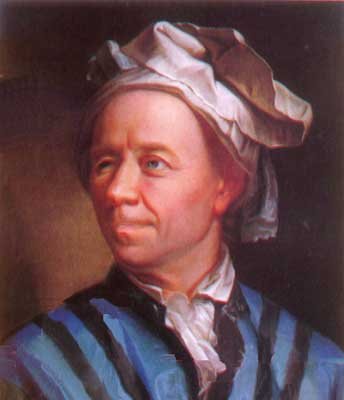
Leonhard Euler
In the course of discussing the series expansion of logarithmic expressions in section 122 of the Introductio, Euler gives the following expansion for an arbitrary base a [7]. (Notice that he wrote it in the way we would today, except that by using log, he intends the log to any base, not necessarily base 10.):
|
$$\log(1+x)={1\over k}\left({x\over 1}-{x^2\over 2}+{x^3\over 3}-\cdots\right)$$
|
After exploring this expansion for values of a such as 1 and 10, Euler then determines a so that k = 1. Using the expansion for a he had given earlier (section 116):
|
$$a=1+{k\over 1}+{k^2\over 1\cdot 2}+{k^3\over 1\cdot 2\cdot 3}+\cdots,$$
|
he obtains:
|
$$a=1+{1\over 1}+{1^2\over 1\cdot 2}+{1^3\over 1\cdot 2\cdot 3}+\cdots$$
|
From this he states that a=2.71828182845904523536028… He then goes on to say [7]:
For the sake of brevity …we will use the symbol e, which we denote the base of the natural or hyperbolic logarithms, which corresponds to the value k = 1, and e represents the sum of the infinite series
|
$$1+{1\over 1}+{1\over 1\cdot 2}+{1\over 1\cdot 2\cdot 3}+\cdots$$
|
Thus Euler gave us the formula
|
$$e=\sum_{n=0}^{\infty}{1\over n!}={1\over 0!}+{1\over 1!}+{1\over 2!}+\cdots,$$
|
and is credited with the notation e.
In the Introductio, Euler also uses the term “natural logarithms” and computes the natural logarithms of the integers 1,2,3,…,10 to 25 decimal places. As far as we know, the term “natural logarithm” was first used by Nicolaus Mercator (1620-1687) in his 1668 Logarithmotechnia [10]. In this work, Mercator uses the binomial theorem to expand ln(1+x) to get the “Mercator series” x/1 - x2/2 + x3/3 - x4/4 + ... [11]. As a side note, in the Introductio we also see the first formal definition of a function as well as the notation f(x) [2].
The Introductio is usually cited as the first place that e appears. And, as urban legend would have it, many people assume Euler chose e for “Euler”. However, this is not the case. Euler’s modesty would not have allowed him such pomp. In all likelihood, he chose e to represent “exponential” or simply because it was the next letter in the alphabet not already used widely for another purpose. But in point of fact, Euler had actually introduced the notation e earlier.
Napier's <em>e</em> - <em>e</em> in Euler's Earlier Work
1736 The first time that e actually appeared in print for the public was in Euler’s 1736 two-volume work on mechanics, Mechanica sive motus scientia analytice exposita [6, op E15, E16]. For simplicity, we will refer to it as the Mechanica. In this work Euler clarifies Newton’s laws of motion through the machinations of calculus [5]. The symbol e also appears in various articles by Euler in the years 1747 and 1751 [3].
However, it was not until after the Mechanica that Euler used e exclusively. In his earlier writings on this subject, he first used the letter c to denote the constant in question. In the Mechanica Euler defines e in terms almost identical to what he would later use in the Introductio [6]. Euler’s use of c was picked up and used by D’Alembert and the astronomer Daniel Melandri, with Laplace using it as late as 1812. However Daniel Bernoulli’s use of e in a 1760 publication may have helped solidify e’s place in mathematics [3].
1731 (1843) In correspondence dated 25 November, 1731 to Christian Goldbach regarding the integral of (1 - x1/n)p [6, letter XV, op 00729], Euler used “e to denote that number whose hyperbolic logarithm is = 1.” [12, p. 97] However, these letters did not get published until 1843.
1727 (1862) Euler wrote so much that often later material was published before earlier, the story being that in later life his son or a colleague would pick up the top several papers on his “done” pile and send them to be published. Thus, older papers were sometimes left on the bottom of the pile. So when looking at Euler’s work, we must look at the date the work was written, since the publication date means little as far as chronology is concerned. A case in point is Euler’s Meditatio in experimenta explosione tormentorum nuper institute (Meditation upon experiments made recently on the firing of Cannon). This work was written in 1727, when Euler was 20 years old, but not published until 1862, 79 years after his death. In this work Euler uses e for the first time in his recorded work [9].
If the Meditatio had been published within a few years of being written, we might be more likely to attribute the use of e to this 1727 work instead of his 1748 Introductio. In either case, we still credit Euler with giving us Euler’s number, 2.71828… And he was indeed the one to give us the notation e. But is it fair to refer to it as “Euler’s number”? Not to be confused with: the Euler Number (of a finite complex K), χ(K); the Euler or Euler-Mascheroni Constant, γ; the Euler Numbers or zig numbers [14]; the Eulerian Numbers; or finally, Euler’s Characteristic, also known as Euler’s Number [13].
Napier's <em>e</em> - Roger Cotes
Among people with some mathematical background, Euler may well be best known for Euler’s formula: eix = cos x + i sin x (also often referred to as the Euler-Cotes formula). In examining the relation between exponentials and trigonometry, Roger Cotes (1682-1716) came to the formula ix = log(cos x + i sin x). This appeared in his Logometria of 1714 (printed in the Philosophical Transactions of the Royal Society, then a widely read publication) and reprinted in his posthumous 1722 work Harmonia Mensurarum. In this work Cotes studied logarithms and their relation to hyperbolas. Defining the “modulus and modular ratio” as the ratio of the number 1 to the factorials, he found the same terms as Euler did in his series expansion above. In particular, Cotes stated the ratio of 2.718281828459 to 1. Thus even our attribution of the decimal expansion of e to Euler is erroneous. But as we saw above, Euler did originally use c. If he had continued with that, urban legend might now say that he named it after Cotes, which would be correct in that Cotes was the first to explicitly write out the numerical approximation for the series expansion.
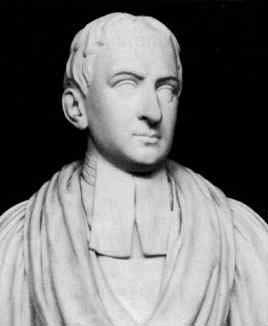
Roger Cotes
Napier's <em>e</em> - Huygens, Leibniz, and Two Bernoullis
In 1690, Jakob Bernoulli (1654-1705) proposed the determination of the catenary or “chain-curve” as a prize problem. Galileo (1564-1642) was the first to pose the question of the mathematical shape of this curve, the shape a chain takes due to gravity when suspended from its ends. The word "catenary" is taken from the Latin catena meaning chain. (Galileo conjectured that the catenary was a parabola, but this was disproved by Joachim Jungius (1587-1657) in 1669 [9].)
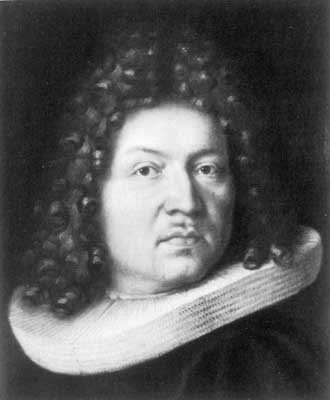
Jacob Bernoulli
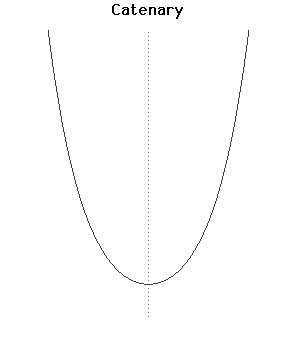
Along with Jakob himself, correct solutions to the catenary problem were given by Sir Isaac Newton (1642-1727) (anonymously) , Gottfried Wilhelm Leibniz (1646-1716), Christiaan Huygens (1629-1695), and Jakob’s younger brother Johann Bernoulli (1667-1748). Huygens was the first to use the term catenary for this problem in a 1690 letter to Leibniz. Though catenary is now the standard term, it was also called the alysoid or chainette [9].

Christiaan Huygens
In modern notation, the solution to the catenary is the hyperbolic function
y = (a/2)(ex/a + e-x/a) = a cosh(x/a).
Correspondence between Leibniz and Huygens discussing the prize problem in October 1690 and January 1691 indicates that Leibniz was aware of the constant 2.7182… In his discussion of the above solution to the catenary, he refers to the constant base (our e) as b [9]: “b estant une grandeur constante, dont le logarithme est 1, et le logarithme de 1 estant 0” [3, p. 13].
This notation probably did not become widespread for two reasons. First, this was in personal correspondence and not a published work. During this time period, many major mathematical and scientific discoveries were made known through personal correspondence that was then circulated among colleagues. Secondly, since the time of Descartes, a, b and c were commonly used to denote the coefficients of polynomials. This might help explain why the use of a to denote the base of the natural logarithm was not adopted either. However, it was suggested in a 1703 review of a textbook on fluxions [3]. So even though b is not a good choice for e, along with a and c, maybe we should call it l for Leibniz’s number. I can’t think of any conflicts with l. But then again, Leibniz, like Euler, gave us a lot of notation, much of our calculus notation being the most obvious. So both Euler and Leibniz do not really need the accolades.
Maybe j for Jakob Bernoulli, since we already decided that b is out. In his 1689 Tractatus de seriebus infinitis, Bernoulli gives us one of our fundamental definitions of e. While investigating various limits, he discovered the link between continuous compound interest and the limit as n appraches infinity of (1 + 1/n)n. Thus Jakob Bernoulli is often credited with defining e as this limit. By using the binomial theorem to expand (1 + 1/n)n, he found that its value was between 2 and 3. So even though he did not refine his expansion enough to get to 2.7…, he did realize that it was a constant. As early as the 1670s, Leibniz and Johann Bernoulli found series expansions for what we now denote as e, ex, and e-x, but did not explicitly state the constant.
Napier's <em>e</em> - Napier
The other common definition of e is that of the base of the natural logarithm. Logarithms were invented over a period of several years around the turn of the seventeenth century by John Napier (1550-1617), the Scottish Baron of Merchiston. Napier published two influential works that laid out the new mathematical tool of logarithms. The second of the two, Mirifici logarithmorum canonis descriptio (Description of the Marvelous Rule of Logarithms), was published first, in 1614, while his Mirifici logarithmorum canonis constructio (Construction of the Marvelous Rule of Logarithms) was published posthumously in 1619 by his son Robert [2].

John Napier
The impetus for his invention was to reduce the multiplication of large numbers required in astronomy and more importantly, navigation. In short, Napier noticed that the angle addition formulas for sine and cosine reduced multiplication to addition. His logarithms have the property that the log of a product can be calculated by adding the logs of the multipliers and then subtracting a constant [8]. His insight can be explained in the following manner: consider two points at rest and initiate motion at the same time. Napier compared the distance traveled by one point moving at uniform velocity on an infinite line to the distance yet to be traveled by a point on a finite line segment moving at a velocity inversely proportional to the distance it still must travel. From this he coined the term “logarithm” meaning “ratio number” in his “second” book, the Descriptio [2, 5, 6]. (However, in his “first” book, the Constructio, he referred to them as artificial numbers [2].) To calculate longitude and latitude, astronomical readings of up to seven digits (found using spherical trigonometry) need to be multiplied. By providing practitioners with extensive log and antilog tables, the large multiplications required could be computed by looking up their logs in a log table, performing addition and subtraction using those two numbers, then converting the answer back into a regular number using an antilog table. To allow for great enough accuracy, Napier took the length of his line to be 107, since sine tables commonly used at the time were taken to seven places.
In Napier’s terms, X=Nap log y, where Nap log (107)=0. Using calculus, Napier’s log can be converted to modern logs using the following conversion [1]:
Nap log y = 107 log1/e(y/107)
In the famous 1615 meeting between Henry Briggs (1561-1631) and Napier and the collaboration that followed, Briggs convinced Napier to revise his system of logs to use the base 10 instead [1, 5]. This new base gave the simplification log(10)=1. Briggs revised Napier’s work, and after the latter’s death, published Arithmetica logarithmica in 1624. This work contained log tables for the base 10 (common logs) to 14 decimal places for the numbers 1-20,000 and 90,000-100,000, which complemented the tables in Napier’s earlier works [11].
Those of us who live on “this side of the pond” refer to Euler’s number, natural logarithms, and common logs for log base 10, while many who live on the “other side of the pond” in Europe use the terms Napier’s constant, Napier’s logarithms, and Briggsian logarithms, respectively. Even though Euler did give us the notation e, and the terms natural and common logs are more descriptive, the British nomenclature may be more in line with the historical development of the concepts. These differences in nomenclature could even be late remnants of the British Isles versus the Continent divide that originated with the Newton/Leibniz controversy and isolated British mathematicians from continental ones for many years. Intriguingly, the “Napierians” do use e for the constant in question. So in tracing the origins of this most ubiquitous number, perhaps n for Napier should be taken under consideration.
Speaking of priority disputes, Napier does not hold the title to logs free and clear. An invention (or should we call it a discovery?) of logarithms and compilation of log tables occurred in Prague in 1620 by Swiss watchmaker Joost Bürgi (1552-1632) [9]. Although Napier had published in 1614, notes and correspondence show that he was working on it as early as 1594, while Bürgi had started his researches in 1588 [1]. But publication won out on this one, and Napier has retained his title to priority. Part of the reason for the long development of logarithms by Napier and Bürgi is that they were working at a time prior to the development of exponential notation such as nx. Without this notation, it is much harder to see the connections between exponentials and logarithms. Eves states that, “One of the oddities in the history of mathematics is the fact that logarithms were discovered before exponents were in use.” [6, p. 186]
Just as Leibniz’s notation for the calculus helped spur the acceleration of developments in calculus by continental mathematicians, the relation between logs and exponents is a good example of how good notation can actually generate mathematics. As indicated above in the Euler discussion, this connection was not explicitly made until Euler. Though Napier retains the title of “first” in the discovery of logarithms, in all fairness to Bürgi whose work was done independently, perhaps we should call it the Napier-Bürgi constant and denote it by nb. But before we close the book on Euler, e and Napier, I would like to make one final suggestion for the name of 2.718…--- "o".
Napier's <em>e</em> - Oughtred
The works of Napier and Briggs contain many tables of logarithms to various bases to facilitate the calculations. Napier’s original 1614 work was, like most scientific works of the time, written in Latin. Englishman Edward Wright translated Napier’s text into English. This version of the Descriptio was printed in two editions, 1616 and 1618. The second edition contains an appendix of tables of logarithms, one entry of which assigns 2.302585 to 10. In modern notation this gives us approximately log2.718 10 = 2.302585 [11]. In general, this appendix contains logs of the form (in modern notation) 106 logex. Thus this is a table of what we would now call natural logarithms. Thus, buried in the work of Napier is the first implicit use of e as a constant. (Keep in mind that when I refer to e, it was not given that designation until Euler over a century later.) However, it is commonly believed that this appendix was not written by Napier, but was compiled by William Oughtred [11].
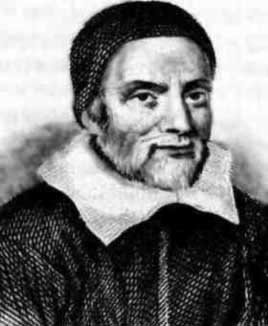
William Oughtred (1574-1660) is known for giving us such notation as X for multiplication and :: for proportion [10]. In relation to his work on logarithms, Oughtred capitalized on Napier’s definition of the log in 1622 to create a simple device for performing arithmetical operations. By placing two rulers in logarithmic scale next to each other, he found he could perform multiplications and other operations by sliding these two rulers along one another, creating the first slide rule [6, 9]. Mitchell and Strain [11] conjecture that this contribution to the development of natural logarithms and e is largely forgotten due to the fact that Briggs’s revision of Napier’s work was much more efficient, thus leaving Napier’s earlier works and, along with them, the appendix of Oughtred, largely unused.
Napier's <em>e</em> - <em>o</em>
We use e to denote the constant 2.7282… associated with continuous compound interest, natural logs and exponential functions. Euler gets the credit for choosing the letter e. And he was the first, and maybe the only one to use it so extensively, giving us so many beautiful and surprising series that converge to some expression containing e, as well as Euler’s identity: eiπ + 1 = 0. But is referring to it as Euler’s number historically accurate?
We have seen that c would have been fitting in light of Cotes’s contribution. However, that could have resulted in some messy business with the quadratic formula, not to mention relativity theory and the speed of light. Since l and j for Leibniz and Jakob Bernoulli sound promising, we will keep those on the table.
The British use of the term Napier’s constant is certainly deserving. Napier’s lasting contribution to mathematics is his invention of logarithms, a term that he coined. However, in much of the world, the only thing his name is associated with is Napier’s Bones or Rods. These ingenious aids to arithmetic from the 1600s are now wholly obsolete (but great fun to make and use in the classroom). They too provided a means (mechanical in this case) of reducing multiplication to a series of single or double digit additions [2]. So the European attribution of the constant to Napier is both realistic in light of the magnitude of his discovery, as well as more egalitarian. So for consistency’s sake, n would be the way to go. Or nb to cover all the bases. But nb and np could throw a few people for a loop.
But, truth be told, the first recorded use of the number that would later be known as e, should go to Oughtred. Continuing with the urban legend that e stands for Euler, I move that we adopt o for Oughtred for 2.71828… But then again, Newton used o to denote his vanishing fluxion in his version of the calculus. And then, there is also the small detail that o could be confused with 0. But this leads to wonderful statements such as: oiπ + 1 = 0 or 1=0.
So we have considered e, c, b, a, l, j, n, nb and o. On second thought, maybe it’s best to just leave it as it is. That is e-sier. And as I always tell my calculus students when they can’t remember how to differentiate ex, “remember, e stands for ‘easy’: to differentiate, just leave it alone.”
Postscript
Euler was the first to imply that e is irrational in 1744, while Lambert published the first rigorous proof of its irrationality in 1768. The number e was shown to be transcendental by Hermite in 1873 [11].
Napier's <em>e</em> - References
- The Development of Mathematics, Dover 1992, (second edition, McGraw-Hill, 1945), pp. 161-162.
- M.J. Bradley, Pioneers of Mathematics: The Age of Genius 1300-1800, Chelsea House Publishing, 2006, pp. 25-26, 35, 111, 115.
- F. Cajori, A History of Mathematical Notations, II, Dover, 1993, p. 13.
- J.H. Conway and R.K. Guy, The Book of Numbers, Copernicus, 1996, p. 25.
- W. Dunham, Euler: The Master of Us All, MAA, 1999, pp. xxiii, 18-20, 25, 34-35.
- L. Euler, Opera Omnia. Virtually all of Euler's work is now available online at the Euler Archives, http://www.math.dartmouth.edu/~euler/
- L. Euler, Introduction to Analysis of the Infinite, Book I, 1748 (English translation by John D. Blanton), Springer-Verlag, 1988, pp. 92-100.
- H. Eves, Great Moments in Mathematics (Before 1650), MAA, pp. 182-189.
- E. Maor, e: The Story of a Number, Princeton University Press, 1994, pp. 13-15, 68, 107, 156.
- MacTutor history of mathematics website, http://www-history.mcs.st-andrews.ac.uk/HistTopics/e.html
- U.G. Mitchell and M. Strain, The Number e, Osiris, I, Jan 1936, pp.476-496.
- R.C. Pierce Jr., A Brief History of Logarithms, The Two-Year College Mathematics Journal, 8, No. 1, Jan 1977, pp. 22-26.
- D.E. Smith, A Source Book in Mathematics, Dover, 1959, pp. 95-98.
- Wolfram MathWorld, http://mathworld.wolfram.com/EulerNumber.html